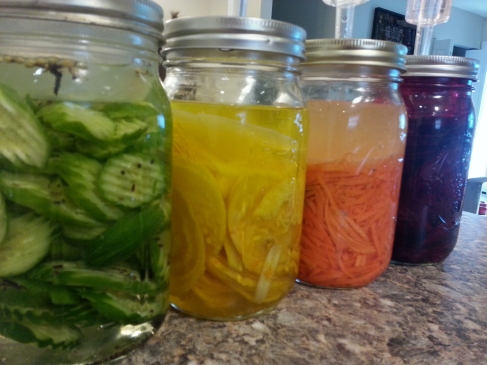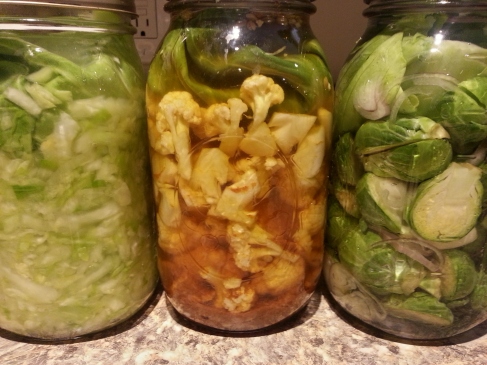Fermented vegetables taste so darn good and are just as good for you. I spent my morning whipping up a few batches and thought I'd share a quick post on how I did it. They just looked too pretty all lined up, not to share would be a crime!
A few words on how fermented foods are good for you. We all know we should eat yogurt cause of the good bacteria and "regulative" properties of it. I mean a certain, will remain un-named, brand has built a whole campaign on how great you will feel after over indulging, if only you eat their yogurt. Fermented vegetables work in a lot of the same ways
- Aid in digestion
- Re-balance the good bacteria in your gut; Many people who suffer from issues like Irritable Bowl Syndrome or Candida, or even Allergies, have an imbalance of beneficial bacteria. Including home-made probiotic foods in their diet often alleviates the symptoms.
- Fermentation increases the nutrients, amino acids, vitamins, and minerals, of the food. It also allows your body to more readily access these nutrients.
You only need a few items to get started: Wide mouth quart size Mason Jars, Sea or Kosher Salt, Vegetables, and a Culture Starter Get it Here
Shred, chop, cube, or slice your vegetable, enough to fill the Mason jar almost to the top. Example: 2 Large Beets, sliced to 1/4 in, 1/2 small head of Cabbage, shredded as if for coleslaw, 4-5 Large Carrots, cut into matchsticks. Experiment to see what ends up working for you with the size and shapes of the veggies you choose.
Boil 1 Quart Filtered Water. When boiling add 2 tablespoons Sea or Kosher Salt and stir to dissolve. Let sit until it reaches room temperature. I often do this the night before and will usually make a few quart at a time since I like to do batches of veggies every few weeks (sometimes days when I get a good haul from the garden or farmer's market). Remember 2 Tbsp Salt per Quart of Water.
Once your water is cooled and your veggies are chopped, begin packing them into the jars. Pack them pretty tightly. Here is where you can get funky with flavorings. I like to add a few chunks of ginger and a grating of orange zest to my beets. I use cumin seed or ginger with my carrots and pickling spice with cucumbers. Pictured below, I added 2 Tbsp of Sambar Powder (see previous post) to chopped Cauliflower. Play around with spices and fresh herbs to change up the flavors.
Once you reach about 1 -1 1/2 inch from the top, sprinkle in about 1/8 tsp. of your starter culture.
Pour your salt water over the veggies, pressing down with your hand occasionally to really get them jammed in there. Fill to the shoulder of the jar making sure none of the veggies rise above the water level. I found that pressing a clean glass tea light holder onto the top of the veggies holds them nicely under water.
Cap and leave for 3-5 days, even up to a week. You should start to see bubbles running through the ferment. When it stops bubbling it is likely done. Uncap and taste, if they taste too salty then let them go for a few more days.
Heartier veggies like cauliflower or brussel sprouts may need up to a few weeks to fully develop their flavor. I left my Saurkraut out for 3 weeks then 2 more in the fridge before uncapping and eating.
Just one note: unless you purchase special fermenting lids like Pickle-Pro Lids you will want to uncap every few days to relieve the pressure.
Fermented foods keep months in the fridge, that is if you don't eat them within days.
Happy Fermenting!


Thanks for the info! I have all my supplies except the veggies. Tomorrow I will run out and pick up some veggies and will try your recipes. Definitely will be trying cauliflower & carrot shreds.
ReplyDeleteI don't understand the starter culture deal. If one buys it does it keep like yeast in an envelope? Or once the container is open does it have to be used quickly? Also the one you recommended (Caldwell) is out of stock. Other suggestions?
ReplyDeleteStarter Cultures do keep like yeast in the fridge. Since the one I use is out you should look for a "Vegetable Starter Culture" Amazon does have some reputable sources. If you are not comfortable using a starter culture you can replace it with 2 Tbsp Whey minus 1 tbsp Sea Salt. I wanted to make this recipe vegan friendly but I have many whey started-lacto-fermeted recipes if you are interested! Email me
ReplyDeleteThe Cauliflower is amazing, takes a couple weeks though. The carrots are ready in days....enjoy!
ReplyDeleteAwesome! How do you know when a ferment is ready?
ReplyDeleteUsually you will see the bubbling subside. But taste it, if it tastes really salty then it's not ready. The saltyness will subside more and more as the vegetable further ferment. Good Luck!
ReplyDelete